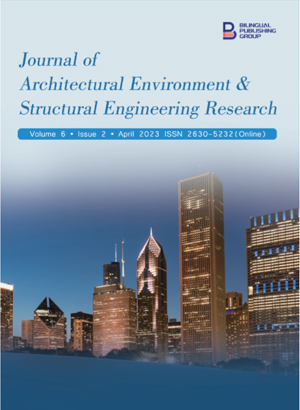-
358
-
207
-
192
-
184
-
179
The Effect of Courtyard Geometry on Airflow Regimes for Ventilation in Tropical Nigerian Environment
DOI:
https://doi.org/10.30564/jaeser.v6i4.5951Abstract
Effective natural ventilation is subject to the ambient wind flow, as well as the conditions of the micro-climate and the geometry of the built structures in the environment. Architects and designers adopt the courtyard concepts for designs in hot tropical climates owing to its unique geometrical characteristics that enable the improvement of airflow required for natural ventilation. This paper presents a review of the airflow regimes within an urban settlement as well as flow regions cultivated when winds interface with courtyard buildings. The impacts of these winds are further studied against different courtyard configurations using schematic analysis based on the H/W ratios, to predict the natural ventilation potentials of various courtyard building types.
Keywords:
Courtyards; Airflow regimes; Courtyard geometry; Natural ventilation; Courtyard ventilationReferences
[1] Bar, S., Cohen-Klonymus, H., Pinsky, S., et al., 2017. Fazael 7: A large Chalcolithic architectural complex in the Jordan Valley, the 2009-2016 excavations. Journal of the Israel Prehistoric Society. 47, 208-247.
[2] Yakubu, P.W., Alibaba, H.Z., 2018. Performance of courtyard systems of housing in hot and humid climate (Bauchi, Nigeria). International Journal of Civil and Structural Engineering Research. 6(2), 128-139.
[3] Srivanit, M., Kazunori, H., 2011. The influence of urban morphology indicators on summer diurnal range of urban climate in Bangkok metropolitan area, Thailand. International Journal of Civil & Environmental Engineering. 11(5), 34-46.
[4] Grimmond, C.S.B., Roth, M., Oke, T.R., et al., 2010. Climate and more sustainable cities: Climate information for improved planning and management of cities (producers/capabilities perspective). Procedia Environmental Sciences. 1, 247-274.
[5] Huang, L., Li, J., Zhao, D., et al., 2008. A fieldwork study on the diurnal changes of urban microclimate in four types of ground cover and urban heat island of Nanjing, China. Building and Environment. 43(1), 7-17.
[6] Ali-Toudert, F., Mayer, H., 2006. Numerical study on the effects of aspect ratio and orientation of an urban street canyon on outdoor thermal comfort in hot and dry climate. Building and Environment. 41(2), 94-108.
[7] Akubue, J.A., 2019. Effects of street geometry on airflow regimes for natural ventilation in three different street configurations in Enugu City. Different Strategies of Housing Design. IntechOpen: London.
[8] Oke, T.R., 1988. Street design and urban canopy layer climate. Energy and Buildings. 11(1-3), 103-113.
[9] Santamouris, M., 2001. Energy and climate in the urban environment. James and James Science Publishers: London.
[10] Zhai, Z., 2006. Application of computational fluid dynamics in building design: Aspects and trends. Indoor and Built Environment. 15(4), 305-313.
[11] Su, Y., Riffat, S.B., Lin, Y.L., et al., 2008. Experimental and CFD study of ventilation flow rate of a Monodraught™ windcatcher. Energy and Buildings. 40(6), 1110-1116.
[12] Ojo, O., 1967. The climates of West Africa. Heinemann: London.
[13] IHVE Guide Book C, 1970. Institution of Heating and Ventilation Engineers: London.
[14] Boutet, T.S., 1987. Air movement. A manual for architects controlling and builders. Mc-Graw Hill: New York.
[15] Mallick, F.H., 1996. Thermal comfort and building design in the tropical climates. Energy and Buildings. 23(3), 161-167.
[16] Oyem, A.A., Igbafe, A.I., 2010. Analysis of the atmospheric aerosol loading over Nigeria. Environmental Research Journal. 4(1), 145-156.
[17] Feustel, H.E., 1999. COMIS—an international multizone air-flow and contaminant transport model. Energy and Buildings. 30(1), 3-18.
[18] Mistriotis, A., Arcidiacono, C., Picuno, P., et al., 1997. Computational analysis of ventilation in greenhouses at zero-and low-wind-speeds. Agricultural and Forest Meteorology. 88(1-4), 121-135.
[19] Kim, Y.C., Yoshida, A., Tamura, Y., 2012. Characteristics of surface wind pressures on low-rise building located among large group of surrounding buildings. Engineering Structures. 35, 18-28.
[20] Ghiaus, C., Allard, F., 2005. Natural ventilation in the urban environment: Assessment and design. Buildings energy and solar technology. Earthscan: London.
[21] Saxon, R., 1994. The atrium comes of age. Longman: London.
[22] Markus, B., 2016. Review of courtyard house in Nigeria: Definitions, history, evolution, typology, and functions. AFRREV STECH: An International Journal of Science and Technology. 5(2), 103-117.
[23] Todhunter, P.E., 1990. Microclimatic variations attributable to urban-canyon asymmetry and orientation. Physical Geography. 11(2), 131-141.
[24] Nakamura, Y., Oke, T.R., 1988. Wind, temperature and stability conditions in an east-west oriented urban canyon. Atmospheric Environment. 22(12), 2691-2700.
[25] Oke, T.R., 1987. Boundary layer climates. Routledge: London.
[26] Hunter, L.J., Johnson, G.T., Watson, I.D., 1992. An investigation of three-dimensional characteristics of flow regimes within the urban canyon. Atmospheric Environment. Part B. Urban Atmosphere. 26(4), 425-432.
[27] Townsend, A.A., 1976. The structure of turbulent shear flow: Boundary layers and wall jets, 2nd edition. Cambridge University Press: Cambridge.
Downloads
How to Cite
Issue
Article Type
License
Copyright © 2023 Jideofor Anselm Akubue, Damilola Omusi Adesina

This is an open access article under the Creative Commons Attribution-NonCommercial 4.0 International (CC BY-NC 4.0) License.




 Jideofor Anselm Akubue
Jideofor Anselm Akubue





